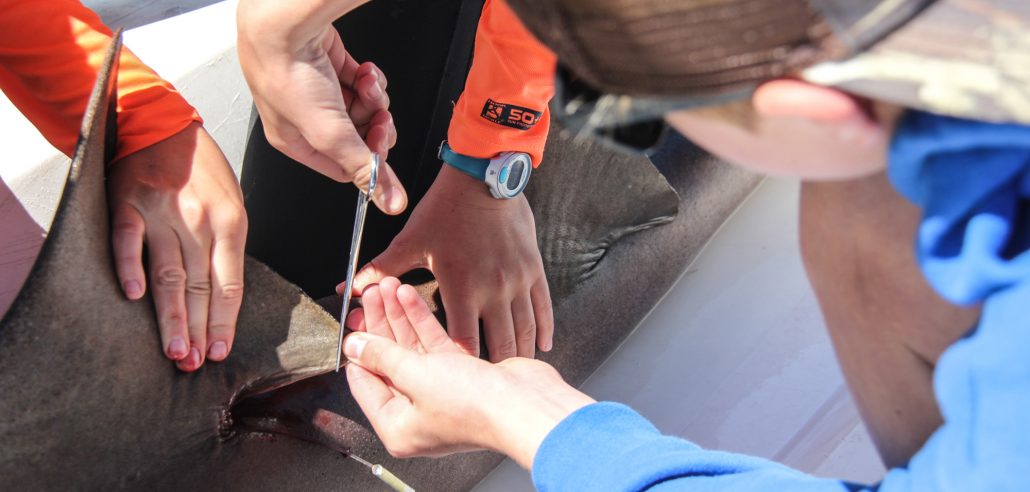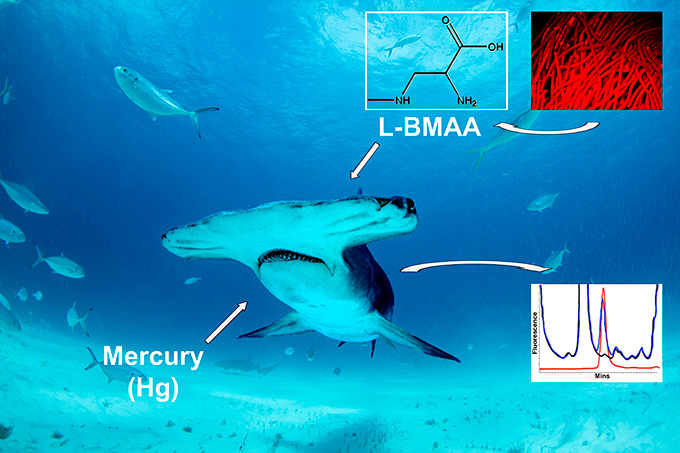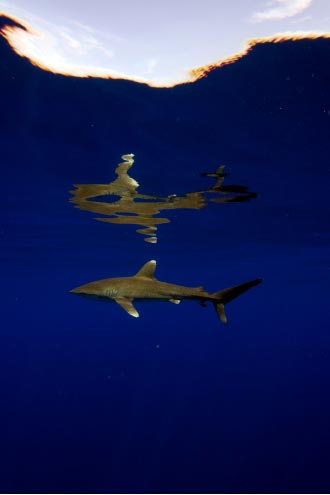As apex marine predators, sharks are susceptible to the accumulation of toxins via the food web. Since sharks are predators, living higher up in the food web, their tissues tend to accumulate and concentrate toxins, which may not only pose a threat to shark health, but also put human consumers of shark parts at a health risk. This research project seeks to measure concentrations of toxins in shark tissues that could pose a threat to both sharks and human consumers.
Recent Study Highlights and Publications
Figure 1: Cyanobacterial neurotoxin β-N-methylamino-L-alanine (BMAA) and Mercury are detected in sharks from the Atlantic and Pacific Oceans
In a new study published in the journal Toxins, our research team examined fins and muscle tissue samples from 10 shark species found in the Atlantic and Pacific Oceans for concentrations of two toxins—mercury and β-N-methylamino-L-alanine (BMAA). Recent studies have linked BMAA to neurodegenerative diseases such as Alzheimer’s disease and amyotrophic lateral sclerosis (ALS). We detected concentrations of both mercury and BMAA in the fins and muscles of all shark species at levels that may pose a threat to human health. While both mercury and BMAA by themselves pose a health risk, together they may also have synergistic toxic impacts. Accordingly, we suggest that restricting consumption of sharks can have positive health benefits for consumers and for shark conservation, since several of the sharks analyzed in the study are threatened with extinction due to overfishing. Fins and muscle tissue samples were collected from 10 shark species found in the Atlantic and Pacific Oceans for concentrations of two toxins—mercury and β-N-methylamino-L-alanine (BMAA).
Wosnick N, Niella Y, Hammerschlag N, Chaves AP, Hauser-Davis RA, da Rocha RC, Jorge MB, de Oliveira RW, Nunes JL. (2021) Negative metal bioaccumulation impacts on systemic shark health and homeostatic balance. Marine Pollution Bulletin. 1;168:112398. https://doi.org/10.1016/j.marpolbul.2021.112398
Shipley ON, Lee CS, Fisher NS, Sternlicht JK, Kattan S, Staaterman ER, Hammerschlag N, Gallagher AJ (2021). Metal concentrations in coastal sharks from The Bahamas with a focus on the Caribbean Reef shark. Scientific Reports 11, 218
Merly L, Lange L, Meÿer M, Hewitt AM, Koen P, Fischer C, Muller J, Schilack V, Wentzel M, Hammerschlag N. (2019). Blood plasma levels of heavy metals and trace elements in white sharks (Carcharodon carcharias) and potential health consequences. Marine Pollution Bulletin; 142: 85-92.
Matulik AG, Kerstetter DW, Hammerschlag N, Divoll T, Hammerschmidt CR, Evers DC. (2017). Bioaccumulation and biomagnification of mercury and methylmercury in four sympatric coastal sharks in a protected subtropical lagoon. Marine Pollution Bulletin; 116(1): 357-364.
Hammerschlag N, Davis DA, Mondo K, Seely MS, Murch SJ, Glover WB, Divoll T, Evers DC, Mash DC. (2016). Cyanobacterial Neurotoxin BMAA and Mercury in Sharks. Toxins 2016, 8, 238.
Rumbold D, Wasno B, Hammerschlag N, Volety A. (2014). Mercury accumulation in sharks from the coastal waters of Southwest Florida. Archives of Environmental Contamination and Toxicology; DOI 10.1007/s00244-014-0050-6
Mondo K, Hammerschlag N, Basile M, Pablo J, Banack SA, Mash DC. (2012). Cyanobacterial Neurotoxin β-N-Methylamino-L-alanine (BMAA) in Shark Fins, Marine Drugs, 10(2), 509-520; doi:10.3390/md10020509
Brand LE, Pablo J, Compton A, Hammerschlag N, Mash DC. (2010). Cyanobacterial Blooms and the Occurrence of the neurotoxin beta-N-methylamino-L-alanine (BMAA) in South Florida Aquatic Food Webs. Harmful Algae 9: 620–635
The Scientific Publications are also available in Mandarin Chinese HERE



